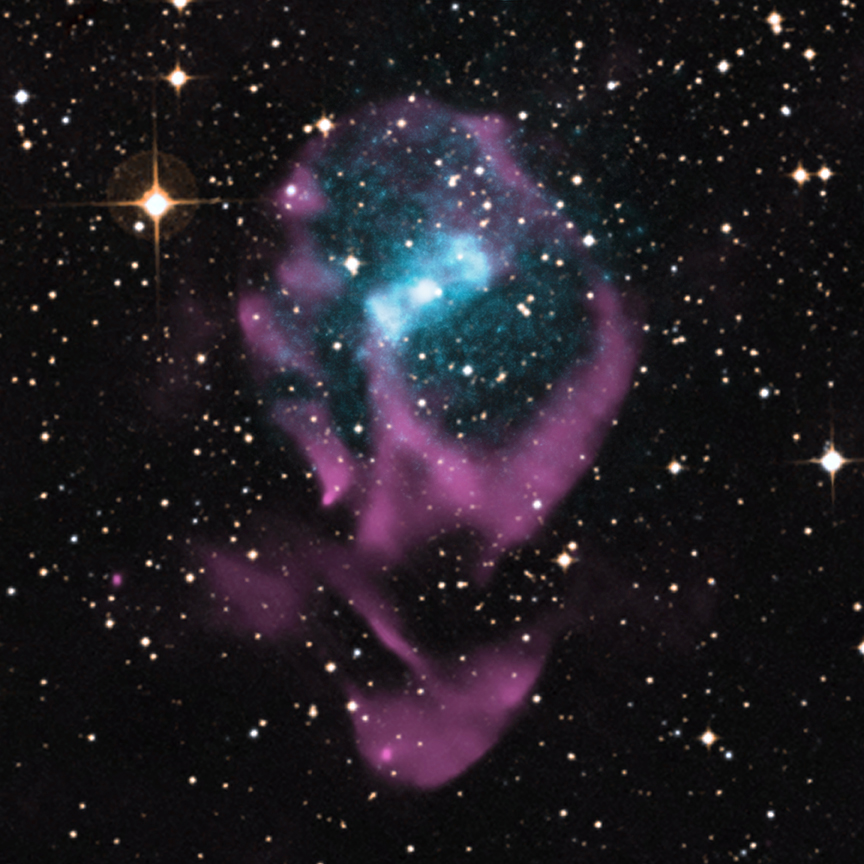The detection of the faint remnant of a supernova has led to the identification of the youngest known member of an important class of astronomical objects. This discovery, made using data from NASA’s Chandra X-ray Observatory and a radio telescope in Australia, will provide scientists with unique insight into the formation of neutron stars and supernovas, as well as the effect of the explosion on a nearby companion star.
>>

Systems known as “X-ray binaries” are some of the brightest X-ray sources in the sky. They consist of a compact stellar remnant – either an ultra-dense neutron star or a black hole – that is paired with a normal star like the Sun. As these two objects orbit one another, the neutron star or black hole pulls gas from the companion star onto it. As the gas falls toward the compact star, it is heated to millions of degrees, producing intense X-radiation.
“X-ray binaries provide us with opportunities to study matter under extreme conditions that would be impossible to recreate in a laboratory,” said Sebastian Heinz of the University of Wisconsin-Madison, who led the study. “For the first time, we can study a newly minted neutron star in an X-ray binary system.”
Heinz and his team – including Dutch astronomers Peter Jonker (SRON), Michiel van der Klis (UvA) and Rudy Wijnands – have discovered that the X-ray binary Circinus X-1 is less than 4,600 years old, making it the youngest ever seen. Astronomers have detected hundreds of X-ray binaries throughout the Milky Way and other nearby galaxies. However, these older X-ray binaries, with ages typically measured in millions of years, only reveal information about what happens much later in the evolution of these systems.
“It’s critical that we see what these X-ray binaries are doing at all stages of their lives,” said co-author Paul Sell, also of the University of Wisconsin-Madison. “Circinus X-1 is letting us see what happens in the cosmic blink of an eye after one of these objects is born.”
The team of astronomers was able to determine the age of Circinus X-1 by examining material around the orbiting pair. While the source itself has been known for decades, the neutron star is usually so bright that the glare from its X-ray light overwhelms any diffuse emission surrounding it. The team caught the neutron star in a very faint state, when it was dim enough to detect the X-rays from the supernova shock wave plowing through the surrounding interstellar gas.
“Since the supernova was triggered by the formation of the neutron star, our limit on the age of the supernova remnant also limits the age of the neutron star in Circinus X-1,” said co-author Robert Fender of the University of Oxford in the UK. The young age of Circinus X-1 helps explain the wild swings in brightness and the highly unusual orbit of the two stars that had puzzled astronomers for years: the orbit is very eccentric (i.e. very non-circular) and the period with which the two stars orbit each other is decreasing by several minutes every year. This is exactly what is expected for a young X-ray binary perturbed by the supernova explosion, before tides due to the gravitational pull of the stars on each other have had time to circularize and stabilize the orbit. Previous observations with other telescopes indicate that the magnetic field of the neutron star in Circinus X-1 is weak. The young age therefore implies either that neutron stars can be born with surprisingly weak magnetic fields, or they can quickly become de-magnetized when material is pulled onto them, neither of which was expected from theories of neutron star evolution.The only other firmly established X-ray binary within a supernova remnant in our Galaxy is SS 433, which has an age between ten thousand and a hundred thousand years, and behaves in many ways like an older version of Circinus X-1. Two other candidate X-ray binaries in nearby galaxies have ages similar to SS433.
In addition to the Chandra data, radio observations from the Australia Telescope Compact Array were critical in these findings. A paper describing these results is available online and appears in the December 4th issue of The Astrophysical Journal. NASA’s Marshall Space Flight Center in Huntsville, Ala., manages the Chandra program for NASA’s Science Mission Directorate in Washington. The Smithsonian Astrophysical Observatory controls Chandra’s science and flight operations from Cambridge, Mass.

